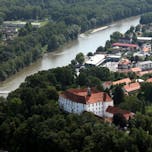
Gornja Radgona Municipality
Radgona Castle
Radgona Castle stands on a 265-metre-high hill, offering a beautiful view of the wider surroundings of Gornja Radgona and the River Mura. The castle was first mentioned in the 12th century, when it was built by the nobleman Radigoj, after whom it was named. Later, the name was also transferred to the town and market below it. For a time, it was believed that the name was connected to the German word “Rad” (wheel), which is also symbolised in the coat of arms of Radgona. The first owners of the castle were the Counts of Spanheim, after which the ownership changed hands frequently.
In 1789, the Herberstein family sold the castle to the Wurmbrandt family, who took exemplary care of it until 1914. At that time, it was bought by Count Karel Chorinsky, who held the estate until 1931, when it was sold off in smaller parcels. After the Second World War, the castle served as a primary school until 1974, but once the school moved out, it quickly fell into decay. By 1991, the castle had been completely looted and devastated, until Milan Herzog took it on lease. With his own resources, he thoroughly restored the building and returned it to its former splendour.

Throughout the centuries, Radgona Castle has undergone numerous reconstructions and extensions. The oldest depiction from 1603 shows an elongated, two-storey building with small windows and two square towers at its sides. A later copper engraving from 1681 depicts a larger structure with fortifications, turrets, and an entrance leading through an outer courtyard. This courtyard is surrounded by a single-storey service building arranged in four wings. The stone portal still preserves its original openings for a drawbridge, as well as a massive lock and iron-clad doors. Above the entrance, visitors can see the Herberstein coat of arms and a stone plaque with an inscription. A sloping ramp leads to the second entrance, where the castle’s inner moat once stood, complete with openings for another drawbridge and a double coat of arms of the Herberstein and Eggenberg families.
The castle’s central building, set around an arcaded courtyard, is two storeys high and fully vaulted with cellars. In the past, the castle had its own well, an impressive 56 metres deep, and a clock tower, which remains one of its landmarks today. The castle’s surroundings were also richly arranged: the Knight’s Avenue leading to the castle was decorated with Baroque busts, of which only two remain today. The road to the castle wound across two stone arches adorned with walls and columns. Opposite the first entrance once stood a chestnut avenue over 50 metres long, ending in a semicircular layout. Today, Radgona Castle is one of the most recognisable landmarks of the region, standing as a proud witness to the town’s rich history and cultural heritage.